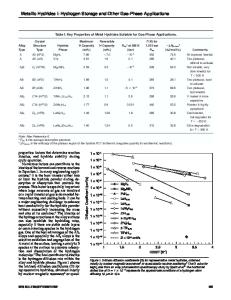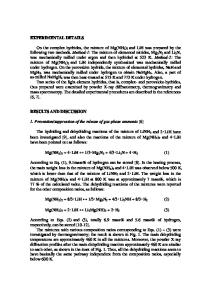Crystal Structure and Hydrogen Storage Properties of novel Mg-Zr-(Li, Na, K) Hydrides Prepared by Gigapascal Hydrogen Pr
- PDF / 398,477 Bytes
- 6 Pages / 612 x 792 pts (letter) Page_size
- 40 Downloads / 375 Views
Crystal Structure and Hydrogen Storage Properties of novel Mg-Zr-(Li, Na, K) Hydrides Prepared by Gigapascal Hydrogen Pressure Method Nobuhiko Takeichi, Kenji Shida, Xiao Yang and Tetsuo Sakai National Institute of Advanced Industrial Science and Technology (AIST), 1-8-31 Midorigaoka, Ikeda, Osaka 563-8577, Japan ABSTRACT Novel Mg-Zr-A (A=Na, Li and K) hydrides have been synthesized by the gigapascal hydrogen pressure method. Their crystal structures were analyzed based on synchrotron X-ray diffraction (XRD) patterns. In the Mg-Zr-H system, the Mg-Zr hydride with FCC structure was formed under 8 GPa and 873 K. In the case of Mg-Zr-Li and Mg-Zr-K systems, the quaternary hydrides were formed and these retained the same crystal structure, FCC structure, up to x = 1.0 While in the Mg-Zr-Na system, the quaternary hydrides were formed and these retained the FCC structure, up to x = 0.3. With the addition of 0.5 NaH, a hydride with the Ca7Ge type structure was formed instead of the FCC structure. The Mg-Zr-(Li, Na, K) hydrides can reversibly absorb and desorb hydrogen. The hydrogen desorption temperatures of those hydrides decrease with the increasing ionic radius of the alkali metal. INTRODUCTION Magnesium is one of the promising elements for hydrogen storage media because of its high hydrogen capacity, 7.6 mass%, as MgH2 [1]. However, the high thermodynamic stability of MgH2 causes difficulty in dehydrogenation at ambient temperature. To improve the reaction kinetics and diffusion properties, reduction of the grain size and the addition of various catalysts have been investigated [2, 3]. Also, various Mg-based alloys and compounds have been investigated in order to improve the reaction kinetics through metallurgical methods such as elemental substitution, mechanical alloying and laminate composites. It is difficult to cast Mg-containing alloys accurately with a desirable composition by conventional melt-cast methods because of the high vapor pressure of Mg, etc. In addition, single phase Mg-containing compounds cannot be obtained simply by casting, due to phase separation during solidification. The hydrogen desorption temperatures of existing materials are still too high, around 573 K at ambient pressure. A more drastic decrease in the hydrogen releasing temperature without reducing the high hydrogen capacity is required for practical applications. High-pressure synthesis is an effective technique to explore novel compounds. Several new Mg-based hydrides were synthesized using multi-anvils [4, 5]. Our group has discovered a series of ternary Mg-rich hydrides such as Mg7TMH x (TM = Ti [6, 7], V [8], Nb [9, 10], Ta [11], Zr [12, 13] and Hf [12]) with a Ca7Ge type structure. The hydrogen desorption temperature of the ternary hydride was lowered sharply compared with that of the pure MgH2. Recently, our group investigated the quaternary hydride [14].
In this study, we have succeeded in synthesizing a series of novel quaternary Mg-Zr-A-H hydrides (A=Li, Na and K) by the gigapascal hydrogen pressure method. In addition, we i
Data Loading...











